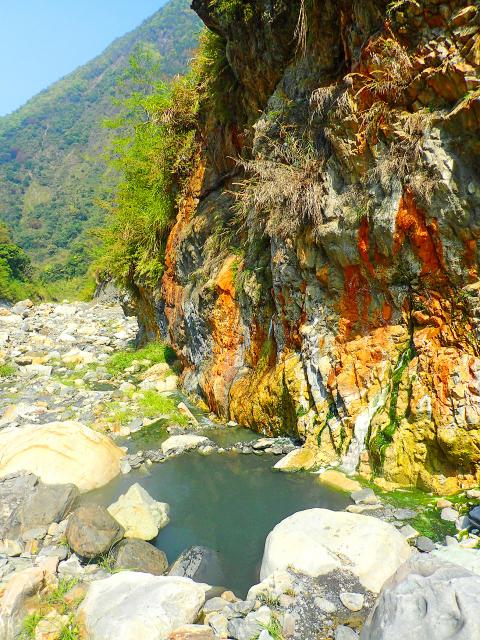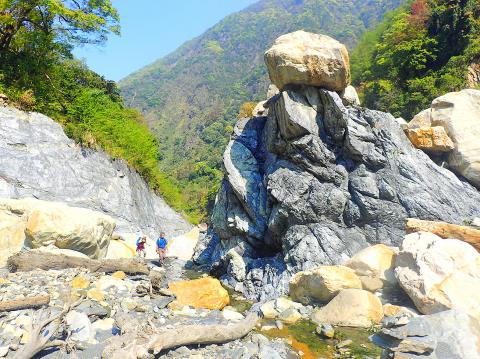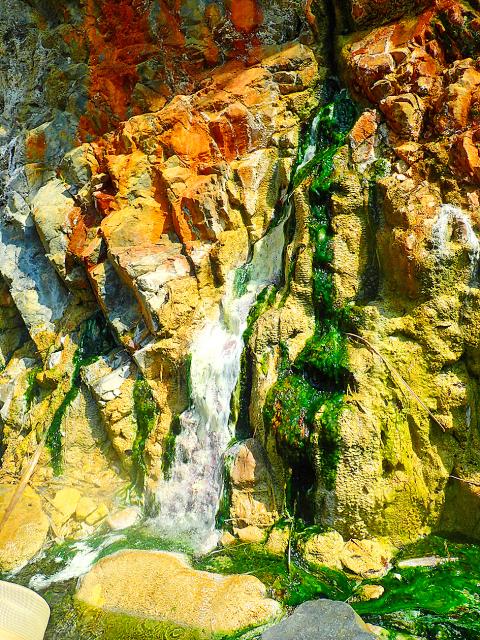Nantou (南投), Taiwan’s only landlocked county, is where I first fell in love with the nation, a few months after arriving here in 1993, when I got a job in an English cram school in a rural part of the county. It’s also one of the richest and most spectacular parts of the country for hikers, river tracers and other nature lovers.
For most tourists, the attractions of Nantou County start and end with Sun Moon Lake (日月潭), a lovely place that has become one of Taiwan’s top tourist draws. Some also get to the Forest Recreation Area at Sitou (溪頭), and since opening in 2005, the Heavenly Steps (天梯) suspension bridge at Jhusan (竹山) has been a huge draw among locals.
It’s worth mentioning, though, that what we can see along the Heavenly Steps trail today is a pale shadow of the true wonders of the (presently inaccessible) main part of Taiji Canyon (太極峽谷), a kilometer or two downstream. When (or rather if) that awe-inspiring place ever reopens to hikers, it will be a major cause for celebration.

Photo: Richard Saunders
NANTOU’S HOT SPRINGS
Among its other tourist draws, Nantou County has more than its fair share of hot springs, although they’ve taken a bit of a battering in recent years.
The springs at Auwanda (奧萬大) near Wushe (霧社) in the north of the county are now all but gone, and most of the crowds visiting the Forest Recreation Area are there either for the cool mountain air, or for the spectacular display of autumn colors (arguably Taiwan’s finest), put on every winter by the forests of maple trees.

Photo: Richard Saunders
Lushan Hot Spring (盧山溫泉; the favorite spa of Chiang Kai-shek, 蔣介石) survives, despite damage caused by a series of typhoons in recent years, and several other hot springs sources in this part of Nantou have been tapped to supply smaller-scale resorts and bath houses.
For such a rugged part of the island, it’s quite surprising that so many of Nantou’s hot spring sources have been developed. Happily, a couple do survive in all their splendidly untouched, natural beauty.
Just below Lushan (the Aboriginal village area, not the hot spring resort downstream), Chingying Hot Spring (精英溫泉), although never formally developed, can be reached by a bumpy one-track road, and is besieged on weekends.

Photo: Richard Saunders
A short clamber upstream, and a couple of small sources have, however, escaped attention and remain attractively untouched. A further kilometer or two upstream, the beautiful Yunhai Hot Spring (雲海溫泉) is unknown to all but keen hikers, as getting up there involves scaling a couple of vertical dam walls on fixed ropes.
LELEGU HOT SPRING
Easier to reach, yet still strenuous and awkward enough to keep all but fit hikers out, Lelegu Hot Spring (樂樂谷溫泉) lies in the deep gorge below Nantou’s second hot spring resort, Dongpu Hot Springs (東埔溫泉). The slightly odd name (which means “happy happy valley”) is in fact a transliteration of the original Bunan Aboriginal name for the hot spring, Laku Laku, which represents the sound of the pressurized, boiling-hot water as it bubbles out of rock faces in the gorge, just above the river.
Before planning a trip to Lelegu Hot Springs, note that the place is one of many around the nation that are officially off-limits to general visitors, yet remain very popular with hikers, so if you go, you do so at your own risk.
The hot springs are accessible year-round, but the best time is December to late April, not only because of the cooler weather, but also because the river level will be lower, making the hike more straightforward. Definitely don’t attempt to visit for several weeks after a typhoon.
Start the journey along Dongpu Rd (東埔路), the main drag of which is lined with hot spring hotels. Walk straight past these and onto Kaigao Lane (開高巷), which contours the hillside, through a tunnel and on to a residential area beyond, where fruit and veg are farmed on the flat alluvial plain at the foot of the gorge.
On the left is the modern trailhead of Batongguan Historic Trail (八通關古道), and for the first hour of the hike, follow it, first zigzagging steeply upwards, then round the sheer, severely eroded bluffs of Father and Son Cliff (父不知子斷崖). About 20 minutes after the cliff, there’s a fork. Turn right, along the trail that descends into the gorge. At first, it’s clear and wide, but soon narrows, and although easy enough to follow, it’s steep in parts, and the thick layer of loose leaf mold makes for slippery footing, so take care.
The trail zigzags down the precipitous face of the gorge, with one or two relatively easy scrambles. At the bottom the trail veers left and levels out, finally reaching the river bank just upstream from a rocky defile through which the water seethes, even during the dry season.
Now simply follow the boulder-strewn left bank of the river. Cairns mark the best route through the maze of huge boulders, rock faces and thickets of tall grass. Keep high and well to the left as the river falls over a small waterfall and rages through a small gorge, and the first hot spring sources are in the rock face on the left just a little further upstream.
The water emerges from the cliff at a perfect temperature for a bath, and there’s usually a pool or two, made from rocks, left by earlier hikers.
About 100 meters upstream is a second area of hot spring sources, spluttering furiously out of the cliff, emitting large clouds of steam, and far too hot to dip even a toe into. Be careful where you tread in this area, as the water is close to boiling point in many places.
Continue another five minutes upstream (this last bit is impossible during the wet season), and more hot spring sources sputter out of the rock into a series of pools. You almost certainly won’t be alone here if you come on a weekend, but it’s a beautiful spot, and you’ll definitely feel happy happy.
Richard Saunders is a classical pianist and writer who has lived in Taiwan since 1993. He’s the founder of a local hiking group, Taipei Hikers, and is the author of six books about Taiwan, including Taiwan 101 and Taipei Escapes. Visit his Web site at www.taiwanoffthebeatentrack.com.

June 2 to June 8 Taiwan’s woodcutters believe that if they see even one speck of red in their cooked rice, no matter how small, an accident is going to happen. Peng Chin-tian (彭錦田) swears that this has proven to be true at every stop during his decades-long career in the logging industry. Along with mining, timber harvesting was once considered the most dangerous profession in Taiwan. Not only were mishaps common during all stages of processing, it was difficult to transport the injured to get medical treatment. Many died during the arduous journey. Peng recounts some of his accidents in

“Why does Taiwan identity decline?”a group of researchers lead by University of Nevada political scientist Austin Wang (王宏恩) asked in a recent paper. After all, it is not difficult to explain the rise in Taiwanese identity after the early 1990s. But no model predicted its decline during the 2016-2018 period, they say. After testing various alternative explanations, Wang et al argue that the fall-off in Taiwanese identity during that period is related to voter hedging based on the performance of the Democratic Progressive Party (DPP). Since the DPP is perceived as the guardian of Taiwan identity, when it performs well,

The Taiwan People’s Party (TPP) on May 18 held a rally in Taichung to mark the anniversary of President William Lai’s (賴清德) inauguration on May 20. The title of the rally could be loosely translated to “May 18 recall fraudulent goods” (518退貨ㄌㄨㄚˋ!). Unlike in English, where the terms are the same, “recall” (退貨) in this context refers to product recalls due to damaged, defective or fraudulent merchandise, not the political recalls (罷免) currently dominating the headlines. I attended the rally to determine if the impression was correct that the TPP under party Chairman Huang Kuo-Chang (黃國昌) had little of a

A short walk beneath the dense Amazon canopy, the forest abruptly opens up. Fallen logs are rotting, the trees grow sparser and the temperature rises in places sunlight hits the ground. This is what 24 years of severe drought looks like in the world’s largest rainforest. But this patch of degraded forest, about the size of a soccer field, is a scientific experiment. Launched in 2000 by Brazilian and British scientists, Esecaflor — short for “Forest Drought Study Project” in Portuguese — set out to simulate a future in which the changing climate could deplete the Amazon of rainfall. It is